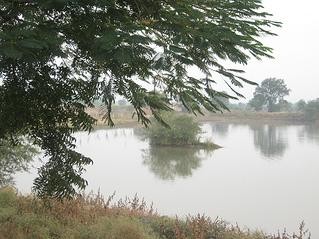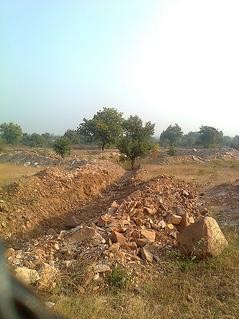
The 200 old revived lake in Valni village, Nagpur
The dire water situation of Valni village and Yogeshji's introduction to the village
Yogesh Aneja ji, is originally from Haryana, and now stays in Nagpur, Maharashtra and runs an auto spare parts business through his own garage in Nagpur. His father worked in the agriculture department in Haryana and that gave him a clear idea of how funds were managed within the government and how difficult it was for funds to reach the farmers. This made him even more sensitive to the issues that the farming communities from villages had to face and motivated him to work with farmers.
He recalls how he insisted on meeting Anna Hazare ji after a meeting in Nagpur and told him of how he wanted to do something for the community and work with him. Anna Hazare ji told him that there was no need to go to a different place, but that he could do something for the community in the area where he was staying presently. Valni village is very close to where he stays in Nagpur and he gradually came to know of the dire water problems of the village and distress of the farmers in the area. He began visiting the village regularly and understanding the problems in the village.
Yogesh ji narrates his story of how when he went to the village, he heard from the villagers that Valni had been receiving water regularly from tankers since 1984 and that the Indo German Watershed Development project implemented in the village was unsuccessful. Yogesh ji noticed that there was a 19 acre lake in the village that had gone dry and felt that something could be done to revive this lake. He took inspiration from Anupam Mishra ji and after reading his book on lakes - Aaj Bhi Khare Hain Talaab, sought his guidance on the issue.
The process of revival through community efforts
He decided to call a meeting of villagers, who were exhausted after meeting one government official after the other, and requesting them for help in cleaning and reviving the age-old water sources in the village, the history of which could be traced to as far as two hundred years. A meeting was thus held and all the villagers together decided that they themselves needed to do something to revive the lake. They hit upon an idea. Everyone in the village knew that the lake was now full of silt and had dried up. But if this silt could be removed from the lake, it would be possible to revive the lake by letting water accumulate in it during the rains. Besides, villagers also knew that the silt from the lake would be extremely useful for their farms and would increase agricultural production.
It was thus decided to hire an earth excavator machine (JCB) that would dig the silt from the lake, and four trucks that would help in lifting the silt from the lake and spread it in the farms, at the rate of Rs 16,000/- for 8 hours. In this way, the villagers spread about 40 trucks of silt in their fields in 8 hours. Each one paid and used the silt according to what they could afford.

Construction of canals in Valni village, Nagpur
The initial taste of success
Very soon, the villagers began to reap the benefits of their actions as they kept on adding silt, in all worth eight lakh rupees over six years. The production in the fields doubled due to the rich silt and the lake got deeper and deeper with a large reserve of water, and helped cope with the drought-like conditions in the area. Some of the rich farmers staying in Nagpur who owned land in Valni village also contributed by adding silt from the lake into their lands by renting the machine and the trucks. This also set an example of how people capable of contributing financially can help in revival of water sources, that can help and be used by the whole village.
The addition of silt to the fields also helped in reduction in the use of chemical fertilisers in the fields and helped in the regeneration of the soil in the area. Thus, revival of the lake not only led to improved production and profit for farmers in an area known for high suicide rates among farmers, but also led to an overall improvement in the environment and in the quality of the soil, making the effort sustainable in the long run. This increased the confidence of the villagers.
Further efforts made by the emboldened villagers
At the same time, the neighbouring village of Savarmenda had started implementing the Gram Sadak Yojana and the contractor of the scheme got in touch with the sarpanch of Valni village as they needed silt, sand, rocks and water and also a place for the workers to stay in the village. The Sarpanch of Valni felt that this was a good opportunity to increase the depth of the lake further and the contractor was thus allowed to dig 15 feet in a two acre portion of the lake for three months. The lake became even deeper. The local Tehsildar who had come to see the project also supported this initiative.
The emboldened villagers, now that the lake had an increased capacity, felt there was a need to have a canal that would help in collecting water from other catchment areas of the village, into the lake. They requested the contractor of the Gram Sadak Yojana this favour, who by then had seen the efforts of the villagers and happily agreed to contribute. He thus made a half-kilometer canal using his earth excavator machine (JCB) machine and this led to a further increase in the water-holding capacity of the lake.
The contractor got the Executive Engineer of the Gram Sadak Yojana to see this effort and they impressed by this effort, made a resolution that a new rule would be made under the Gram Sadak Yojana and the same idea would be implemented in other villages as well, where people would be encouraged to use materials for making roads in their own village by using silt, and in the process make new lakes or revive existing lakes.
Future plans of the villagers of Valni
The villagers have not stopped at this point. As Yogesh ji says, we have started the development of the village based on three basic principles. The first one being, focus on interlinking water channels within the village. Thus, newer efforts are being made in the village to construct a number of canals and small bunds that would help in directing all the rainwater into the lake and prevent any wastage of water. In addition to this, Yogeshji also encouraged farmers to construct farm ponds within their private lands to aid in irrigation for agriculture. The village thus now has thirty two farm ponds and aims at constructing hundred more such ponds.
The second principle, includes introduction of natural farming techniques based on the principles of live and let live, which would encourage restoration of the ecosystem through use of earthworms, no use of artificial or chemical fertilisers and pesticides, and the third being introduction of complete farming that would include planting of fruits and vegetables in any of the open spaces available in the village.
The current progress made by the village
The water table in the village has risen considerably because of the efforts of the villagers over the last fifteen years. Whats more, everyone in the village has a toilet, as compared to earlier days when open defecation was very common.
Yogesh ji takes us to the home of Keshav Dambhare, a farmer in the Valni, who has taken a lead role in encouraging farmers to introduce farm ponds within their land. Here we also meet Shrikrishna Bhade and Nathu Phalke, who have been active participants in this initiative, who take us to see the revived lake as well as the farm ponds and canals that help to interlink water channels in the village.

A farm pond in one of the farmer's fields in Valni, Nagpur
It took us fifteen years to reach here, informs Yogeshji. He says, that this effort can be a model, of how local people taking initiative on their own, including raising financial resources, without depending on any external agencies such as NGOs or the government, can bring about change, in terms of a transition from a water-scarce village to a water-abundant one.
"This is not at all difficult to do, most of it is just about common sense. What is important is to have that readiness, motivation and the sheer determination to go on till you get results", he adds. "At the same time, sensitivity to the problems of the farmers and better support from government officials would greatly help and would go a very long way in changing the situation of the farmers in the area".